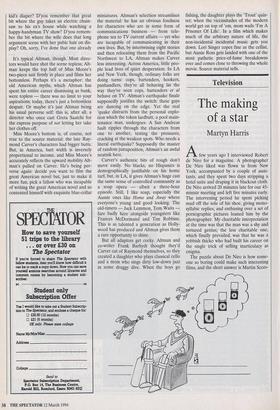Television
The making of a star
Martyn Harris
Afew years ago I interviewed Robert de Niro for a magazine. A photographer De Niro liked was flown in from New York, accompanied by a couple of assis- tants, and they spent two days stripping a hotel suite and draping it in blackout cloth. De Niro arrived 20 minutes late for our 45- minute meeting and left five minutes early. The intervening period he spent picking mud off the sole of his shoe, giving mono- syllabic replies, and enthusing over a set of pornographic pictures loaned him by the photographer. My charitable interpretation at the time was that the man was a shy and tortured genius; the less charitable one, which finally prevailed, was that he was a yobbish thicko who had built his career on the single trick of selling inarticulacy as enigma.
The puzzle about De Niro is how some- one so boring could make such interesting films, and the short answer is Martin Scors- ese. Most of the great roles which Quentin Tarantino drooled over in Cinefile (Chan- nel 4, Sunday, 9 p.m.) — Mean Streets, Taxi Driver, Raging Bull, Goodfellas — were Scorsese pictures. When it wasn't Scorsese it was Coppola in Godfather Two (an over- rated movie, in which De Niro speaks bare- ly a dozen lines in English); or Michael Cimino in The Deerhunter (an increasingly embarrassing film in retrospect).
Harvey Keitel or Christopher Walken could have taken any of the parts. Without a first-class director, in the mediocre films he has made since the mid-1980s — Jack- knife, Guilty by Suspicion, Stanley and Iris — De Niro has revealed himself as little more than a mannered minimalist. The crinkly grin; the baleful stare; the heavily advertised remodelling of his body; the immobility which overlays the oh-so-barely- contained bursts of violence: De Niro's real role is as the film-school wimp's idea of a hard man. Quentin Tarantino, maker of Reservoir Dogs — that fashionably balletic bloodbath — is just such a wimp, and his eulogy to De Niro revealed more of the fervid interior life of the director than the two-dimensional personality of the star.
On BBC 2 on Tuesday (8.50p.m.) Sister Wendy began her Grand Tour in Florence, with Botticelli's Venus who was, she told us helpfully, an idealised woman: 'You can't imagine her washing up with those hands.' A male artist's rendering of Judith carrying the head of Holofernes was also idealised, but a female painter's version was less ide- alised: 'She has a basket to carry the head in. Much more practical.' Visiting a monastery she argued that the fabulous Fra Angelico frescoes on the walls of the monk's cells were not really luxuries but aids to meditation and the spiritual life. Perhaps this is the story she gives the Mother Superior when she jets off to her next destination, which is Sienna I think. Sister Wendy seems like a nice old bat, so we shouldn't begrudge her, but I don't know if her amiable witterings really add up to an arts programme.
My favourite show of the week was Toys For The Boys (Channel 4, Wednesday, 9.45p.m.) which followed Hew Kennedy's obsessive attempt to build a trebuchet, which is a kind of mediaeval siege engine. Kennedy is a professional eccentric, and his engine lacked much authenticity, being constructed with the aid of arc welding gear, and cranked by a Land Rover. What was engaging was the oblique style of film- ing, whereby one never quite saw the engine until the moment of its first trial, when it launched an old upright piano through the air. The camera angle opened and the piano arched lazily through the sky. We saw the trebuchet for the first time, impossibly huge, its neck rocking like a demented dinosaur, and we caught the piano as it hit the ground with its built-in petrol bomb, exploding in a geranium of flame. It was an epiphany of pointless endeavour, and perfectly delightful.



















































 Previous page
Previous page